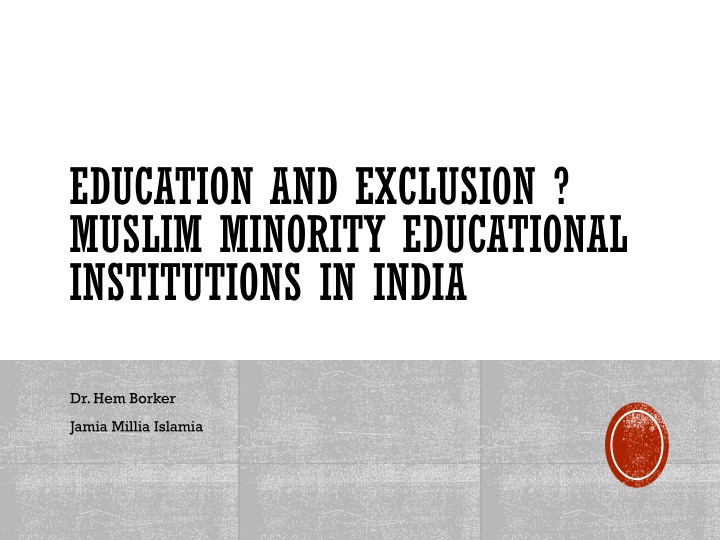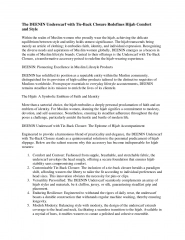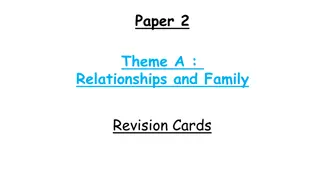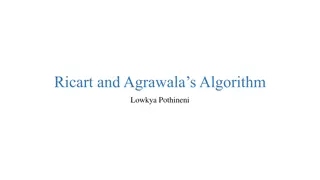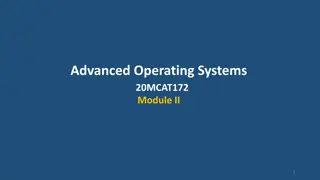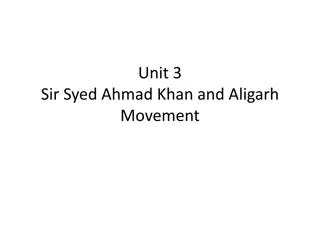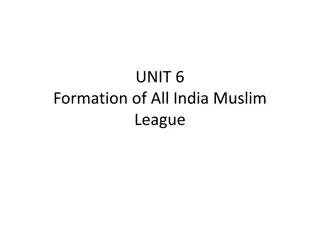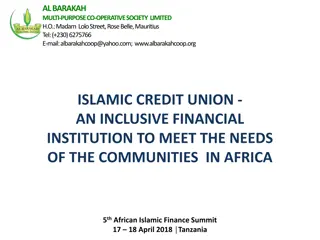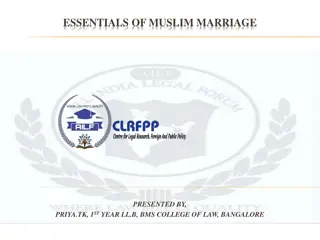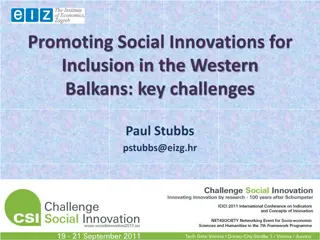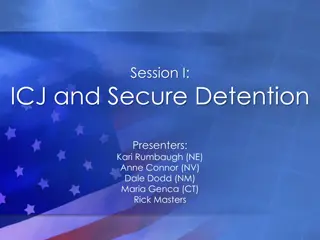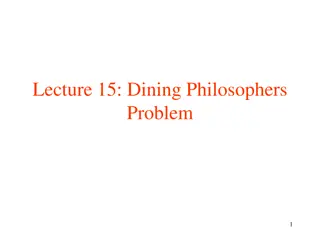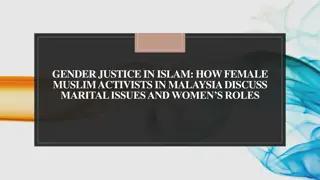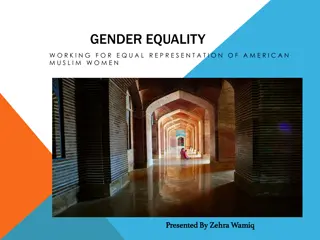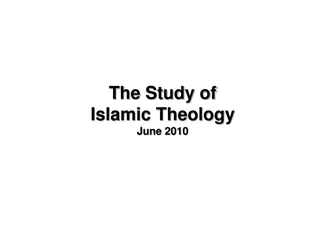Muslim Educational Exclusion in India: Challenges and Solutions
Minority Educational Institutions in India, particularly those serving the Muslim community, face challenges such as low literacy rates, high dropout rates, and declining enrollment in higher education. Despite constitutional mandates for inclusion, disparities persist. Efforts are needed to address these issues and ensure equitable access to education for all students.
Download Presentation

Please find below an Image/Link to download the presentation.
The content on the website is provided AS IS for your information and personal use only. It may not be sold, licensed, or shared on other websites without obtaining consent from the author.If you encounter any issues during the download, it is possible that the publisher has removed the file from their server.
You are allowed to download the files provided on this website for personal or commercial use, subject to the condition that they are used lawfully. All files are the property of their respective owners.
The content on the website is provided AS IS for your information and personal use only. It may not be sold, licensed, or shared on other websites without obtaining consent from the author.
E N D
Presentation Transcript
EDUCATION AND EXCLUSION ? MUSLIM MINORITY EDUCATIONAL INSTITUTIONS IN INDIA Dr. Hem Borker Jamia Millia Islamia
Minority Educational Institutions (MEIs) are established and managed by the members of a religious/linguistic minority community and meant to serve educational interests of the community of belonging CONSTITUTIONAL MANDATE This vision of inclusion was highlighted by Dr. B.R. Ambedkar in Constituent Assembly debates, 1948: Non-discriminatory clauses: Article 29 Protection of Interests of the Minorities No educational establishments founded and run by religious and linguistic minorities discrimination by state against No discrimination in granting recognition or assistance to such institutions solely based on their minority status. Article 30 Right of minorities to establish and administer institutions educational Inclusion Keeping the MEI s open to students from all communities to ensure safeguarding their rights - cannot be compelled against their will to join classes on religion. inclusivity while
MUSLIM MINORITY EDUCATIONAL INSTITUTIONS Primary Schooling to Higher Education levels Schools Institutions of Higher Education Universities Professional Colleges ITIs/Polytechnics Madrasas
MUSLIM EDUCATIONAL EXCLUSION Literacy : The literacy rate among Muslims is the lowest as compared to other communities (GoI, 2007). High percentage of children (15%) who have never attended school (GoI, 2014) and the lowest mean years of schooling (GoI, 2006). Drop Outs : High dropouts beginning at a young age of 10 years, as compared to other socio-religious communities (GoI, 2014, NSSO 75th Round , 2017-18 ) The rate of dropouts increases with the increase in the level of education resulting in the low presence of Muslims at higher levels of education as compared to other socio-religious communities (GoI, 2014).
Central Universities 8.41 to 8.24% Institutions of national importance 1.92 to 1.87% Public-funded state universities 5.29 to 4.30% DECLINE IN MUSLIM ENROLMENT MUSLIMS DECLINED FROM 5.4% IN 2019-20 TO 4.6% (AISHE, GOI) Self-financed private universities 4.25 to 3.87% Government deemed universities 1.10 to 1.03% Government-aided deemed universities 14.55 to 11.84% Self-financed private deemed universities 3.47 to 3.04% Colleges of central universities 4.68 to 3.58% Colleges of state universities from 6.05 to 5.09%
VIEWS OF MUSLIM STUDENTS : MUSLIM MIE ARE ACCESSIBLE, AFFORDABLE, ACCOUNTABLE, ASPIRATIONAL Affordable The institution takes staggered fees for the girls when the money from the scholarships or after the agricultural season Degree College, Bijnor, Uttar Pradesh Achievable , Accessible I am an tailor. I studied still class 7th. My two boys are getting good marks but 90 percent is less in India today, competition is a lot.. this institution is accessible.. they can get through engineering here Parent admitting son in BA programme, Delhi, JMI Aligarh Muslim University has an internal quota for its own students students join secondary school to become eligible for the quota for engineering and medicine. Student, AMU
Familial I got into top universities in Delhi but opted for this as I did my schooling (11th/ 12th), BA, MA and now PhD I like mahual - egalitarian culture, secular education and religious ethos it is a place I feel at home Phd Student, Jamia Millia Islamia (JMI). Accountable No studies stake place in regular government colleges, boys stand outside and loaf around (awaragardi), eve tease girls (ladkiyon ko chedte hain).. There is some accountability (jawabdari) here Parent of College Graduate , Bijnor Aspirational value Getting in JMI, AMU for students in Rural Bihar, UP, Mewat is like getting into Oxford and Cambridge.. School Principal, Ranchi
Safety My parents were fearful in sending me to pursue higher education outside Kashmir..Delhi being the closest and Jamia being a minority university located in a Muslim area with lots and lots of Kashmiris around they were ok with me coming here and living in a hostel. Phd scholar, JMI, Delhi Gendered Reasons I wanted to study Sciences but I was told I could only go to a girls college and this is the only Muslim girls degree college here , it only offers Bachelors in Arts programme BA Student, Bulandshahar, Uttar Pradesh I studied in a Co-ed Urdu medium Minority school 85% students were girls because these schools are considered best (most appropriate) for girls, then I joined this Technical College for Muslim Minorities as it was the closest to home. BSc. Computers, Karad , Maharashtra
REACHING THE ASPIRED HIGHER EDUCATION DESTINATIONS : MEI S AS A PARADOXICAL RESOURCE Raising Aspirations & Getting good Jobs My family has a wood business in Saharanpur. I thought eventually as the only son I will manage it. Earlier I only wanted to complete a degree I enrolled in BA programme at Aligarh Muslim University. There I lived in the hostel and joined activities like debating. That made me realise I can win debates. When the CAA came, I joined the protests. On social media I had to explain what was wrong in the Act. Now I am doing my Phd on Pasmanda Muslims..I can never go back to being that quiet, apolitical small businessman personality Phd Scholar Jamia Millia Islamia. My brother came to know that with his marks he could study BPharma from Muslim college Hardoi, Neither he nor my parents knew that there was a job- oriented option like Pharmacy we thought there was only BSc or Medicine. Student , Bijnor, Uttar Pradesh
EDUCATION TO CAREERS : ASPIRATION CAPS Inability to access Dominant Social Networks Minority Tag : Construct of being a Minority Institution Wider Political processes marked by Rise of right-wing forces
STEPPING OUTSIDE THE BUBBLE Inability to Access dominant Social Network Unemployment is bad everywhere, that s why it s a national election issue but things have become really bad for Muslim institutions placement this year it is not even 30%. This 30 number is also owing to our Alumni network. Student Coordinator, Placement Cell, Jamia Millia Islamia All the good jobs are taken by the students who come from better backgrounds they are educated in private schools, speak good English, know how to present themselves and have contacts ... the rich students get placed first and the ones who really need a job, the students with good marks but ordinary background, get left behind. Student , Jamia Millia Islamia
MEI GRADUATES ENTERING THE JOB MARKET : MINORITY TAG I joined as a JRF after topping in my bachelors and masters. I chose to study here over other universities that offered me a doctoral place because I felt it s this university that made me realize my academic potential .. but now I realise Jamia is a bubble. In interviews for academic posts I was asked what are my views on Ghazwa-e-Hind which has no correlation to my doctoral work on climate change. Phd Scholar , Jamia Millia Islamia In the feedback session we were told the students need better orientation, Muslim students are spoilt in Muslim institutions.. They are not professionals . .making much fuss about dress and prayers Student, Placement Cell, Malana Azad National Urdu University , Hyderabad The State Rural livelihood Mission which recruits from our Department , openly(khule aam) - offers Delhi University graduates a higher salary package than Jamia for the same entry level position. We cannot keep explaining to everyone that JMI is equivalent and in fact has a better national ranking than DU .. MSW , Jamia Millia Islamia
DOUBLE BIND : Concerns regarding safety , discrimination leads Muslims to only limit (self-confine) themselves to minority institutions Processes that restrict social mobility to Good Jobs (high status and/or salary jobs)
POLICY VIEW VS FIELD VIEW The policy view The education lag of Muslims is explained by emphasising religious and cultural factors internal to the community rather than socio socio-economic marginalisation (Alam, 2013). This includes citing Religious conservatism and socio- cultural ethos of Muslims (Baig 1974; Borooah and Iyer 2005; Sharma 1978; Vajpeyi 1989) Conservative gender norms (See Hussain, 2022; Sherin, 2023) Muslim preference for identity-based community institutions such as madrasas and Muslim minority education institutions (Borker, 2018). The policy discourse contains a stated commitment to educational equality. It ostensibly addresses the educational marginalization of Muslims youth by offering opportunities for inclusion in mainstream quality higher and technical educational institutions. Commitment is not reflected in policy action. There is very low investments in creating greater access of Muslim students to quality mainstream educational avenues. A good example is the downward slide in student aid and scholarships available for Muslim youth.
DECLINE IN MINORITY SCHOLARSHIPS Withdrawal of Scholarships: Central Government cancelled two scholarships for Minority Students in November 2022 Pre-matric scholarship (class 1 to 8) Maulana Azad National Fellowship (MANF) for M.Phil and PhD programmes Decrease in Spending : Between 2019 and 2022, the govt spending on 6 educational schemes for religious minorities dropped by around 12.5% and the number of beneficiaries declined by 7% Implementation Issues: CBGA report Analysis the Union Budget 2022-23 highlights poor coverage of beneficiaries. Utilisation of the budget under the scholarship schemes in the last quarter of financial year -beneficiary students receive their scholarships end of the academic year. Inadequate scholarship Amount
VICIOUS CYCLE Educational Disadvantage of Muslims Policy Emphasis on religious and cultural factors as explaining educational backwardness of Muslims Exclusionary Inclusion in MEI s Low investment in expanding Greater Access of Muslim students to Mainstream Educational options Reducing responsibility of education of Muslims to minority educational institutions
